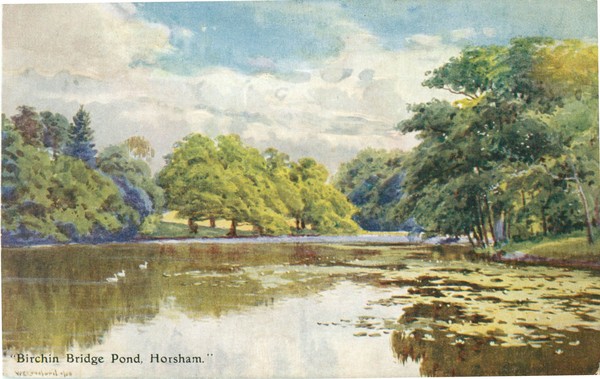Samuel Combridge & Charles Frederick Cook

Birchin Bridge Pond, Horsham (South Downs Series)
Antiquarian booksellers, stationers and lending library proprietors at 56 Church Road in Hove, and after the First World War also at 70 Church Road (where a John Southey and Emily Combridge lived). Samuel Combridge was born at Hove in about 1867 and was the son of Daniel T. Combridge (a butcher) and Rhoda R. Combridge. In 1901 Samuel was still living with his parents at 5 Leopold Road in Brighton, but was already working as a bookseller and stationer. He founded the Church Road business by 1903 and ran it on his own until about 1911 when he went into partnership with Cook. In 1911 he was living at Oakthorpe, 23 Bigwood Avenue in Hove with his wife Miriam, to whom he had been married for a year, and daughter Muriel Paddison Combridge, who was 9 months old. By 1918 Samuel and his family had moved to 15 Wilbury Villas. Charles Cook lived at 24 Shelley Road, before moving by 1911 to 3 Westbourne Gardens in Hove. After 1927 he lived at 15 Park Avenue. He was married to Ada Cook. Directories show that the partnership between Combridge and Cook lasted until the 1930s when Combridge retired, handing over the reins to Cook.
The two partners published the popular "Sunny Sussex" and "South Downs" series of facsimiles of coloured paintings of picturesque Sussex towns and villages. The principal artists were William Edward Croxford and Warren Williams. Places depicted include Alfriston, Beeding, Bramber, Bury, Chichester, Ditchling, Edburton, Falmer, Horsham, Midhurst, Poynings, Sompting and Wilmington. The first cards in the two series appeared in 1906, and both series seem to have remained on sale until after the First World War. A second Sunny Sussex series followed the first. Strangely, the South Downs Series featured many Wealden places while Downland places were sometimes included in the Sunny Sussex Series.
Many Sunny Sussex cards are labelled on the back "Combridge's Library, Hove", but cards in the South Downs series that were printed from 1909 onwards are labelled "S.C., H.", which is obviously intended as an abbreviation of "S. Combridge, Hove".
Many of the cards have a fleur-de-lis trademark on the reverse, but others are unornamented. They were printed in Britain using a halftone process in which the components dots are organised into rings, which was quite advanced for the period. It is generally accepted that J. Salmon Ltd. of Sevenoaks printed and supplied the Combridge cards.
W. E. Croxford is known to have painted views for Salmon. Leo Hare reports that Croxford was born to Charles and Anne Croxford (formerly Castle) at Brentford in Middlesex in 1851. He married Emma Marina McIntyre (1856-1932) in Brentwood, before moving with her to Hastings and subsequently St Ives in Cornwall. He painted mainly watercolours, including seascapes, and often exhibited at the Royal Academy. He also painted Minton porcelain plates. He died in 1926.
Warren Williams was born in 1860 in Liverpool, which was where he received his education. He lived for most of his working life in Conway in North Wales and produced many fine watercolours of the coast and mountains. He produced watercolours for a number of postcard publishers, including E. T. W. Dennis of Scarborough. He died in 1941.
Croxford produced far more watercolous for Combridge than Williams, who seems to have largely confined his attention to area around Worthing. He did, however, paint a view of Preston Road in Brighton for Dennis, which was published in their Dainty Series.
Some late printings of the South Downs cards omit all reference to Combridge and are actually labelled "Printed & published by J. Salmon, Ltd."
In his book, The dictionary of picture postcards in Britain, 1894-1939 (1984, Antique Collectors' Club, London), A. W. Coysh mentions that Combridge's Library also published cards of cricketers.
In addition to Combridge, William Brooker of Eastbourne produced a "South Downs Series" of cards. These poorly printed sepia-tinted real photographic cards were on sale in the 1920s.
Acknowledgement: Leo Hare (Hurst Green) had kindly provided much of the above biographical information about Croxford and Williams.
To directory of publishersTo gallery
Design: Lucid Design
© www.sussexpostcards.info
